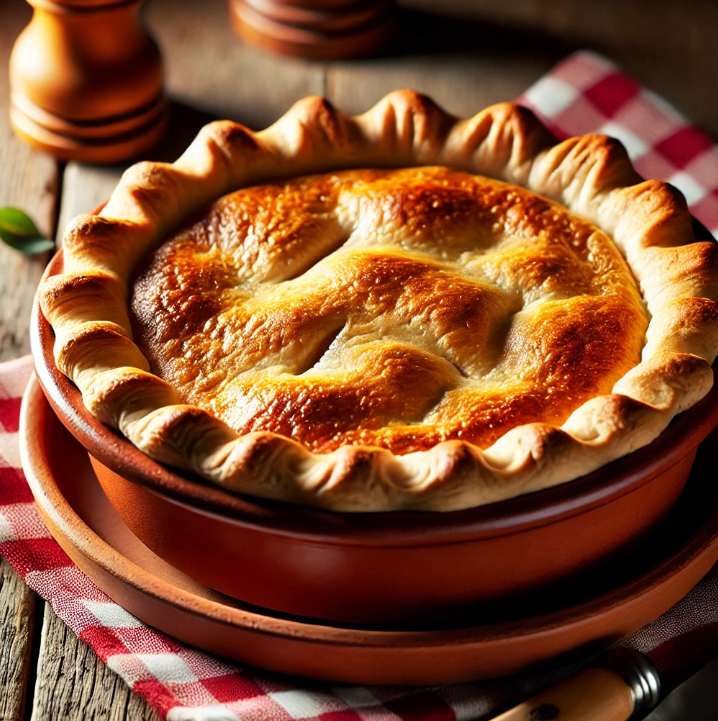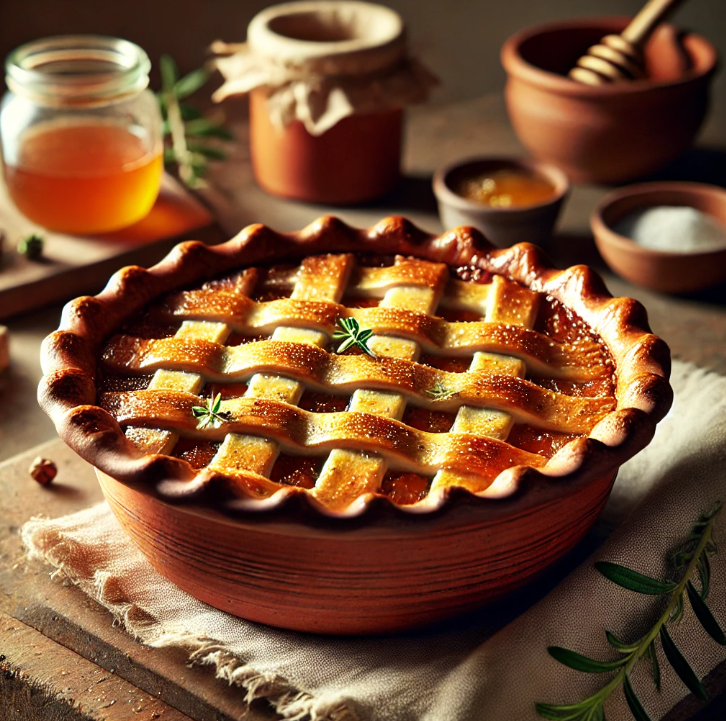Imagine the charm of a freshly baked pie, served straight from a rustic terracotta dish. Not only does this traditional baking method offer an earthy, artisanal appeal, but it also enhances the flavors and textures of your pie like no other cookware. In this article, we’ll explore everything there is to know about Terracotta Pie, from its history and preparation to the benefits of using terracotta in your kitchen. Whether you’re a fan of savory meat pies or crave the sweetness of a fruit-filled delight, this guide will inspire you to embrace the art of terracotta cooking.
Table of Contents
Introduction to Terracotta Pie
What is a Terracotta Pie?
A Terracotta Pie is no ordinary baked treat; it’s a fusion of tradition and flavor crafted using a terracotta dish. These dishes, made from durable, heat-retaining clay, have been staples in kitchens for centuries. What sets a terracotta pie apart is the even heat distribution provided by the dish, ensuring a perfectly golden crust and a well-cooked filling. Whether you’re preparing a savory chicken pie or a classic apple pie, terracotta enhances every bite.
Terracotta cookware has roots in ancient civilizations, where clay pots were used for baking due to their ability to retain moisture and evenly cook food. Fast forward to modern times, and these versatile dishes are making a comeback among food enthusiasts who value flavor and sustainability.
The Role of Terracotta in Cooking
What makes terracotta so special? First, its porous nature absorbs moisture, releasing it during cooking to keep pies tender and flavorful. Second, the even heat distribution eliminates the risk of hot spots, which can ruin delicate pastry. Lastly, terracotta’s natural material imparts a subtle earthy aroma that elevates the overall taste of the dish.
Whether you’re hosting a family gathering or experimenting with new recipes, terracotta pies bring warmth and nostalgia to your table. This timeless technique is a perfect blend of practicality and culinary art.
The Magic of Cooking with Terracotta
How Terracotta Elevates Pie Baking
Baking a Terracotta Pie isn’t just about creating delicious food—it’s about elevating your cooking experience. Terracotta dishes are renowned for their ability to evenly distribute heat, ensuring that every part of your pie, from the flaky crust to the gooey filling, is cooked to perfection.
Unlike metal pans, terracotta retains heat longer, so your pie stays warm even after it’s taken out of the oven. Plus, the gentle cooking process prevents burnt edges or undercooked centers, a common issue with traditional bakeware. Whether you’re preparing a savory chicken pot pie or a sweet peach cobbler, terracotta guarantees consistently impressive results.
Another bonus? Terracotta’s porous surface absorbs and releases moisture during baking, preventing your pie from becoming dry. This unique quality locks in flavors and creates a tender, melt-in-your-mouth texture.
Versatility of Terracotta Dishes
Terracotta cookware isn’t just for pies—it’s incredibly versatile. You can use it to bake bread, roast vegetables, or even make casseroles. Its durability and adaptability make it a must-have in any kitchen.
For example, a savory Terracotta Pie filled with spinach and feta is just as delightful as a traditional apple pie. The dish’s ability to adapt to different recipes and cuisines means you’ll never run out of ideas. Whether you’re experimenting with fusion flavors or sticking to classic recipes, terracotta brings out the best in every dish.
Preparing a Terracotta Pie
Choosing the Right Ingredients
When it comes to making a Terracotta Pie, quality ingredients are key. Fresh produce and high-quality proteins can make all the difference in taste and texture.
- Savory Pies: Ingredients like tender chicken, flavorful sausage, or hearty vegetables (think potatoes, carrots, and leeks) work wonders. Adding fresh herbs like thyme or rosemary enhances the savory profile.
- Sweet Pies: For sweet options, fruits like apples, peaches, or berries are ideal. Choose ripe, seasonal fruits for the best flavor. Don’t forget to add a touch of cinnamon, nutmeg, or vanilla for extra depth.
Prepping the Terracotta Dish
Before diving into your recipe, it’s essential to prep your terracotta dish correctly.
- Season the Dish: If it’s your first time using a terracotta dish, soak it in water for 30 minutes to enhance its heat-retaining properties.
- Grease the Dish: Lightly coat the interior with butter or oil to prevent sticking and promote a golden crust.
- Preheat with Care: Place the terracotta dish in the oven while preheating. This gradual heating prevents cracking and ensures even cooking.
Assembling the Pie
To assemble your Terracotta Pie, start by rolling out your dough and carefully lining the dish. Add your chosen filling, ensuring an even layer for uniform cooking. Top with another sheet of dough or a decorative lattice pattern, then seal the edges to lock in the flavors.
Once assembled, bake your pie at a moderate temperature (typically 350°F) for 45–60 minutes, depending on the filling. The result? A visually stunning and deliciously satisfying pie that’s ready to impress.
Variations of Terracotta Pie
Exploring Unique Terracotta Pie Twists
Terracotta pie is as versatile as it is delicious. From rich savory flavors to innovative sweet creations, this dish offers endless opportunities for experimentation. You can replace the traditional fillings with ingredients like spiced chickpeas, herbed mushrooms, or caramelized onions for a vegetarian twist. Sweet versions often feature fruits like apples or berries, combined with creamy custards.
Check out recipes like Pumpkin Cheesecake Brownies to see how traditional techniques meet modern flavors.
Pairing Flavors for a Unique Experience
Complementary side dishes enhance the terracotta pie’s flavors. Serve savory versions with crisp green salads or roasted vegetables. Sweet options pair beautifully with whipped cream, ice cream, or a drizzle of caramel sauce. Don’t be afraid to think outside the box—pairings like spicy sauces or tangy chutneys elevate the pie into a standout dish.
Frequently Asked Questions About Terracotta Pie
What Makes a Terracotta Pie Unique?
The hallmark of a terracotta pie is its use of earthy terracotta cookware, which ensures even baking and imparts a unique flavor. The method retains moisture while adding a rustic, artisanal touch to your presentation.
Is Terracotta Pie Healthy?
Absolutely! The ingredients often feature fresh vegetables, lean proteins, and nutrient-rich grains, making it a wholesome meal. Sweet versions can also be made healthier with alternatives like natural sweeteners and whole-grain crusts.
For More Delicious Recipes
For a collection of inspiring recipes that bring out the best in terracotta pie, explore Recipes to Explore. Their wide array of options ensures you’ll find the perfect match for your culinary cravings.
Cooking and Baking Techniques for Terracotta Pie
Preparing the Terracotta Dish for Baking
Using terracotta cookware is one of the secrets to perfecting a Terracotta Pie. Before you start, it’s important to season the dish correctly. Soak the terracotta pot in water for about 15–20 minutes before use. This prevents cracking and ensures even heat distribution during baking. Additionally, lightly oil the dish to prevent the crust from sticking. Whether you’re using a store-bought or homemade pie crust, proper preparation makes all the difference.
Baking to Perfection
The key to a delicious terracotta pie lies in baking it slowly at a moderate temperature. Preheat your oven to 375°F (190°C), and place the pie in the middle rack for even cooking. Use a foil cover or lid for the first half of the baking process to retain moisture and prevent the top from browning too quickly. Remove the cover for the last 15–20 minutes to achieve that golden, flaky crust. The terracotta dish locks in heat beautifully, ensuring that the filling cooks evenly while the crust stays crisp.
Troubleshooting Common Issues
If the pie filling is too runny, consider adding a thickening agent like cornstarch or flour before baking. For an overly dry crust, brushing the surface with a light egg wash or melted butter will help seal in moisture. Lastly, if your crust is browning too quickly, simply tent it with foil to slow the process.
Serving and Storing Terracotta Pie
Creative Serving Suggestions
Serving Terracotta Pie can be as creative as making it. For a savory pie, garnish with fresh herbs like parsley or thyme before serving. Sweet pies benefit from a dusting of powdered sugar or a dollop of whipped cream on the side. Serving it directly in the terracotta dish not only enhances its rustic charm but also keeps the pie warm for longer.
Pairing the pie with complementary sides elevates the meal. For instance, a savory terracotta pie pairs well with roasted potatoes or steamed greens, while a sweet pie shines alongside vanilla ice cream or fruit compote.
Storing Leftovers
If you’ve got leftovers, storing terracotta pie is a breeze. Allow the pie to cool completely before covering it tightly with foil or transferring it to an airtight container. Savory pies can last up to three days in the fridge, while sweet versions stay fresh for four to five days. For longer storage, freeze individual portions in sealed containers. When reheating, use a low oven temperature to preserve the dish’s flavor and texture.
Serving Freshly Baked or Next-Day
One of the joys of terracotta pie is its ability to taste just as good—if not better—the next day. The flavors meld beautifully overnight, making it an excellent make-ahead option for gatherings or meal prep.
For a dessert that works well with terracotta, try Lemon Blueberry Cookies to enjoy the perfect mix of tradition and taste.
The Sustainability of Terracotta Pie
Eco-Friendly Cooking with Terracotta
Making a Terracotta Pie isn’t just about flavor—it’s also a step toward sustainable cooking. Terracotta cookware is made from natural clay, a renewable resource, and it’s completely biodegradable at the end of its lifecycle. By using a terracotta dish, you’re reducing your reliance on synthetic, non-biodegradable bakeware, contributing to a greener planet.
Unlike disposable aluminum pans or plastic containers, terracotta dishes can be reused countless times, cutting down on kitchen waste. Plus, the energy-efficient heat retention of terracotta means you can bake at slightly lower temperatures, saving energy in the long run.
Durability That Lasts
Terracotta cookware is built to stand the test of time. With proper care, your dish can last for decades, making it a worthwhile investment. Its longevity not only saves money but also reduces the need for frequent replacements, which often end up in landfills. Embracing terracotta is a simple yet impactful way to enjoy cooking while minimizing environmental impact.
For a dish where even heat matters, try this comforting Easy Wor Wonton Soup Recipe.
Popular Terracotta Pie Recipes to Try
Sweet Terracotta Pie Recipes
Terracotta dishes shine when it comes to baking sweet pies. A classic apple pie, for instance, takes on a rustic, artisanal quality when baked in terracotta. The dish’s even heat distribution caramelizes the sugars in the filling, creating a golden-brown crust and a perfectly gooey interior. Other popular sweet pies include peach, mixed berry, and pumpkin—each of which benefits from terracotta’s ability to lock in moisture.
For those looking for something unique, try a chocolate and hazelnut terracotta pie. The creamy chocolate filling contrasts beautifully with the flaky crust, offering a rich and decadent dessert that’s perfect for special occasions.
Savory Terracotta Pie Recipes
On the savory side, terracotta is ideal for hearty meat pies and quiches. A traditional chicken pot pie, loaded with vegetables and creamy gravy, is a comforting option that’s elevated by the rustic terracotta dish. For vegetarians, a spinach and feta terracotta pie offers a flavorful and satisfying meal.
You can also experiment with international flavors, like a spicy Indian keema pie or a Mediterranean-inspired pie with olives, sundried tomatoes, and goat cheese. These recipes highlight the versatility of terracotta cookware, allowing you to adapt it to any cuisine or preference.
Getting Creative with Leftovers
A great way to make the most of terracotta pie is by repurposing leftovers. Transform a savory pie into a breakfast hash or turn a sweet pie into a topping for yogurt or ice cream. The possibilities are endless, making terracotta pie a practical and delicious addition to your culinary repertoire.
For more inspiration on crafting the perfect Terracotta Pie, check out the incredible collection of recipes on Food Network. From sweet classics to savory delights, you’ll find a variety of ideas to elevate your terracotta baking game!


